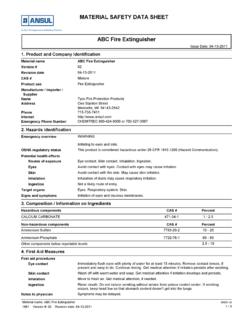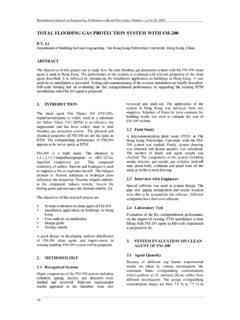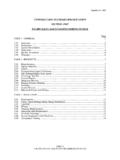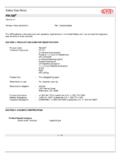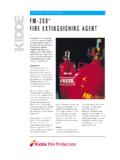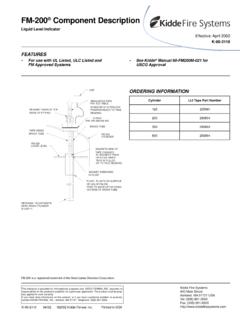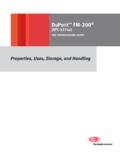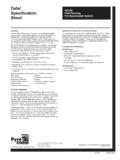Transcription of FM-200 (Fire Extinguishing Agent)
1 MATERIAL SAFETY DATA SHEET FM-200 ( fire Extinguishing agent ) Revision Date: February 9, 2009 Page 1 of 6 1. IDENTIFICATION OF THE SUBSTANCE/PREPARATIONS AND OF THE COMPANY UNDERTAKING Product Name FM-200 ( fire Extinguishing agent ) Other Trade Names Heptafluoropropane, HFC-227ea Product Description fire Extinguishing agent Manufacturer/Supplier Kidde Residential and Commercial Address 1016 Corporate Park Drive Mebane, NC 27302 USA Phone Number (919) 563-5911 (919) 304-8200 Chemtrec Number (for emergencies only) (800) 424-9300 (703) 527-3887 (International) Revision Date.
2 February 9, 2009 MSDS Date: January 15, 2007 Safety Data Sheet according to EC directive 2001/59/EC and OSHA s Hazcom Standard (29 CFR ) 2. HAZARDS IDENTIFICATION EU Main Hazards Non Flammable Gas Routes of Entry - Eye contact - Inhalation - Skin contact Carcinogenic Status Not considered carcinogenic by NTP, IARC, and OSHA. Target Organs - Respiratory System - Skin - Eye - Cardiovascular System - Central Nervous System Health Effects - Eyes Direct contact with the cold gas or liquid can cause freezing of exposed tissues, with pain, redness, burns and corneal damage.
3 Health Effects - Skin Direct contact with the cold gas or liquid can cause freezing of exposed tissues. Health Effects - Ingestion Ingestion is not a possible route of exposure. Health Effects - Inhalation Exposure to vapor at high concentrations have the following effects: - light headedness - dizziness - difficulty with breathing - drowsiness - nausea - mental confusion - increased blood pressure increased respiratory rate - heart irregularities - loss of consciousness - suffocation if air is displaced by vapors.
4 Individuals with preexisting diseases of the cardiovascular system or nervous system may have increased susceptibility from excessive exposures. 3. COMPOSITION/INFORMATION ON INGREDIENTS Component Name CAS#/Codes Concentration R Phrases EU Classification 1,1,1,2,3,3,3-Heptafluoropropane 431-89-0 EC#207-079-2 > None Non Flammable Gas MATERIAL SAFETY DATA SHEET FM-200 ( fire Extinguishing agent ) Revision Date: February 9, 2009 Page 2 of 6 4. FIRST AID MEASURES Eyes Immediately flood the eye with plenty of warm water for at least 15 minutes, holding the eye open.
5 Obtain medical attention if soreness or redness persists. Skin Flush with water. Obtain medical attention if frostbite or blistering occurs or redness persists. Ingestion Ingestion is not considered a potential route of exposure. Inhalation Remove from exposure. If there is difficulty in breathing, give oxygen. Obtain medical attention immediately. Advice to Physicians In case of frostbite, place the frostbitten part in warm water. If warm water is not available or impractical to use, wrap the affected parts gently in blankets.
6 DO NOT USE HOT WATER. The use of epinephrine or similar compounds can increase susceptibility to heart irregularities caused by excessive exposure to these types of compounds. 5. fire - FIGHTING MEASURES Extinguishing Media FM-200 is used as an Extinguishing agent and therefore is not a problem when trying to control a blaze. Use Extinguishing agent appropriate to other materials involved. Keep containers and surroundings cool with water spray as containers may rupture or burst in the heat of a fire .
7 Unusual fire and Explosion Hazards Containers may explode in heat of fire . Protective Equipment for fire -Fighting Wear full protective clothing and self-contained breathing apparatus as appropriate for specific fire conditions. 6. ACCIDENTAL RELEASE MEASURES Wear full protective clothing and self-contained breathing apparatus. Remove leaking cylinder to a safe place. Ventilate the area. Leaks inside confined spaces may cause suffocation as vapors may displace air, and should not be entered without a self-contained breathing apparatus.
8 7. HANDLING AND STORAGE Containers should be properly stored and secured to prevent falling or being knocked over. Do not drag, slide or roll containers. Do not drop containers or permit them to strike against each other. Never apply flame or localized heat directly to any part of the containers. Store away from sources of heat or ignition. Storage area should be: - cool - dry - well ventilated - under cover - out of direct sunlight 8. EXPOSURE CONTROLS/PERSONAL PROTECTION Occupational Exposure Standards Occupational exposure limits are listed below, if they exist.
9 1,1,1,2,3,3,3-Heptafluoropropane None established. MATERIAL SAFETY DATA SHEET FM-200 ( fire Extinguishing agent ) Revision Date: February 9, 2009 Page 3 of 6 8. EXPOSURE CONTROLS/PERSONAL PROTECTION Engineering Control Measures Use with adequate ventilation. There should be local procedures for the selection, training, inspection and maintenance of this equipment. When used in large volumes or odor becomes apparent, use local exhaust ventilation. Respiratory Protection Not normally required under conditions of use as a portable fire extinguisher.
10 For other applications creating oxygen deficient atmospheres, use a self contained breathing apparatus, as an air purifying respirator will not provide protection. Hand Protection Wear rubber gloves. Avoid contact with skin. Eye Protection Chemical goggles or safety glasses with side shields. Avoid contact with eyes. Body Protection Normal work wear. 9. PHYSICAL AND CHEMICAL PROPERTIES Physical State Liquefied gas under pressure Color Colorless Odor Odorless Specific Gravity Boiling Range/Point ( C/F) oF Flash Point (PMCC) ( C/F) Not Flammable Solubility in Water 260 mg/L Vapor Density (Air = 1) Vapor Pressure psia @ 70oF Gas Density lb/ft3 @ 70oF Evaporation Rate Not applicable 10.
